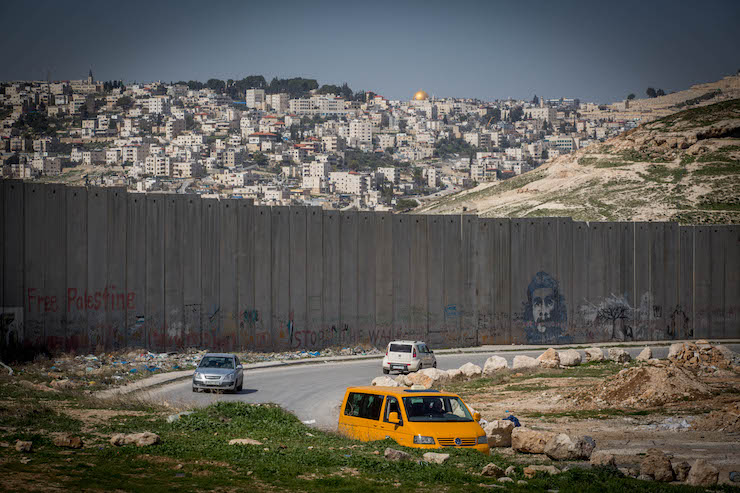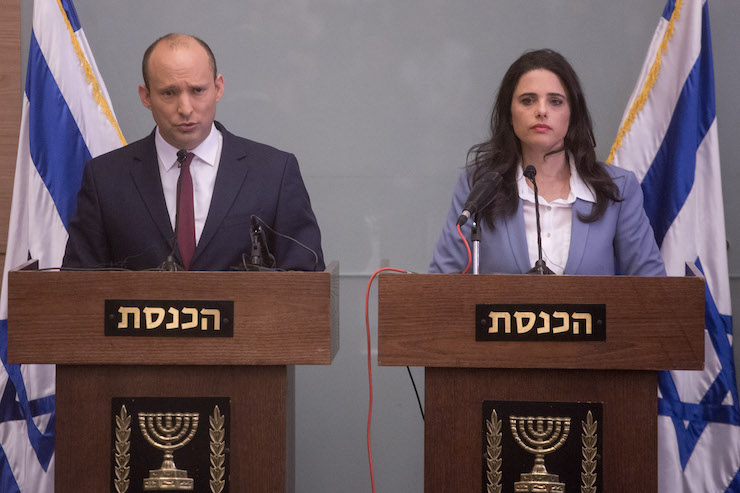For a long time, politicians perpetuated the idea that Israel sought peace and a two-state solution, even while taking contradictory steps on the ground. In these elections, that dissonance seems to be dwindling. A look at what each party is saying.

The scramble to predict who might win the Israeli elections is understandable, but it begs a towering question: Will the next government actually change anything? To hone in further: Will it change Israel’s direction on the Israeli-Palestinian conflict?
The left is inclined to say there’s no difference between centrist challengers Blue and White party and Netanyahu’s ruling Likud. Netanyahu’s campaign slogan “Bibi or Tibi,” referring to a prominent Arab politician, is a compact way of saying that anything to his left means the end of Jewish identity in Israel.
How is a voter to gauge the difference between the parties’ policies regarding the conflict? Maybe voters aren’t trying. A survey I did for B’Tselem in December found that just over one-fifth of respondents chose “resolving the conflict” as one of their top two national priorities — on a list of six problems Israel needs to solve, it ranked fourth.
The parties appear to be mindful of the public disinterest. On Monday night, the Geneva Initiative held an event billed as “the great debate” on policy toward the conflict, scheduled with representatives of Likud, Blue and White, Labor, The New Right (Naftali Bennett and Ayelet Shaked’s far-right party), and left-wing Meretz. Likud and Blue/White cancelled last minute. It appears that the leading parties prefer not to risk losing control over any of the few words they release on this issue.
The two most serious contenders for Israel’s premiership may not have shown up, but a look at their platforms shows what the parties claim to stand for. What do they actually propose? Do they differ from one another, and would they truly change current policies? Here at +972 Magazine we often analyze how Israeli policy plays out on the ground for real people – but what does Israel tell itself it wishes to do?

Blue and White, the centrist slate challenging Likud, has been accused of having no coherent ideology than replacing Netanyahu. Still, the party managed to release a platform last week (Hebrew). The chapter on the conflict mentions the word “Palestinian” twice and nowhere else: first, to propose “accelerating economic development in Palestinian Authority areas”; and second, in support for separating from the Palestinians. The word “occupation” does not appear.
The only indication of long-term vision is its desire to “preserve a horizon for a future agreement.” To do this, Blue and White proposes initiating a regional conference.
Is this a departure from Israel’s current policy? Netanyahu has often spoken of economic peace, by which he seems to mean improving daily life at the expense of Palestinian national self-determination. Blue and White also does not discuss Palestinian statehood or a two-state solution. The shape of the missing entity can be surmised based Blue/White’s proposal to “strengthen the large settlement blocs” and make the Jordan Valley Israel’s “eastern security border” (probably intended to avoid the term “international border”). With beefed-up settlement blocs on the western edge of the West Bank and a thick Israeli-controlled band lining the eastern edge, the squeezed bubble in between seems to be the space allotted for Palestinians.
Blue and White does not name the political final status it has in mind, just like Likud under Netanyahu. It avoids mentioning a Palestinian state, while outlining a geographic area surrounded by Israeli settlements and an Israeli military presence in perpetuity. As for economic peace and a regional initiative, if Blue and White gets into power, it will have Netanyahu to thank for laying the groundwork for both.

In looking for differences between the parties, two items turn up: Blue and White’s explicit desire for “separation,” and its absence of explicit support for settlement expansion beyond the so-called blocs. Likud does not openly support the latter either, but allows such expansion in practice. Would Blue and White stop or roll back those settlements? It’s unlikely. Yoaz Hendel, Netanyahu’s former communications adviser, ninth on the Blue and White list, recently said that party leader Benny Ganz rejects unilateral withdrawal. Yet he also said “there is no possibility of a peace agreement.” Hence, no end to settlements beyond the blocs.
Comparing this with the incumbent Netanyahu/Likud leadership isn’t easy. For the last three election cycles, following 2009, the Likud has declined to offer a platform on conflict resolution or anything else.
One way to discern what Likud has in mind is a video from February 5th, in which a parade of top Likud figures stated their support for extending Israeli sovereignty over the West Bank. Everyone had something to say. Zev Elkin, minister of environmental protection and Jerusalem affairs, advocated sovereignty over the West Bank to prevent Palestinians from implementing “the salami method,” saying “they take and they take, while we give.” Tourism Minister Yariv Levin said sovereignty over all land of Israel “not a matter of if but when.” Science and Technology Minister Ofir Akunis, Social Equality Minister Gila Gamliel and others agree, and the approach complements a 2017 decision by the Likud Central Committee to advance annexation over the whole territory. The video was created by a movement called “Sovereignty.”
If Likud’s future vision is full formal annexation, that does contradict Blue and White’s platform of separation. Moreover, the separation paradigm is still the common theme of parties to its left.
Hadash, a Jewish-Arab party viewed as far-left in Israeli terms, states support for “dismantling all settlements and establishing an independent Palestinian state next to Israel, with its capital in East Jerusalem, and a just solution for the [Palestinian] refugee problem according to UN resolutions.” The term “all settlements” means removing the major blocs as well as outlying settlements.

This prompts accusations by both right-wingers and some on the left that the approach acknowledges a mixed population of Jews and Arabs inside Israel, while demanding a Palestinian state free of Jews. In fact, the traditional two-state plans based on negotiations over the last 20 years all propose evacuating settlements from areas intended to become a future Palestinian state. The same accusation therefore could be made against any party supporting the two state solution – except that at present, hardly any party does.
The Labor party platform, for example, reads somewhat like Netanyahu’s 2009 Bar Ilan speech – a grudging, conditional, and circumscribed version of a Palestinian state as the basis of a two-state solution: “Our diplomatic vision is a regional agreement with the Palestinians and with the moderate Arab states, and in this framework a demilitarized Palestinian state will be established next to us.” Labor, too, advocates separation. It would end “isolated settlements and strongholds,” without specifying what happens to the large settlement blocs. There’s no reason to think Labor would support removing them.
By contrast, Meretz walks a line that is both clear and careful. The party supports the establishment of a Palestinian state without qualification. The platform advocates the Arab Peace Initiative and division of the land based on the 1967 borders. Whether by design or not, Meretz does not mention dividing people. It advocates an immediate freeze of settlement construction – avoiding the third rail of evacuation and presumably referring to all settlements, not just those beyond the blocs. In Israel-Palestine-language, that’s an acknowledgement all new construction is a declaration to Palestinians that Israel rejects peace.
Despite the poor prospects for the Israeli left, these positions still matter. When Israeli parties enter a coalition, they do so after bargaining for the principles they want the government to advance. Precisely because Blue and White is not black and white about its vision, the positions of the hypothetical coalition partners could affect the bottom line of its policies.
And what if Likud wins, along with a majority for the right-wing bloc, leading to another right-wing coalition?
Alongside the Likud video, visions of annexation have been hiding in plain sight for years. Naftali Bennett published his detailed plan for annexing Area C prior to his first electoral run in 2013 and he has stuck with the basic idea. His New Right party, co-headed by Justice Minister Ayelet Shaked, states clearly: the party opposes territorial concessions and opposes a Palestinian state. New Right advocates settlement everywhere, and calls again for annexing Area C, where it claims half a million Israelis live alongside 80,000 “Arabs.” The numbers are important, since Israeli Jews worry constantly about a “demographic threat” to the country’s Jewish majority.

The best independent sources estimate that in reality, somewhere between 200,000 and 300,000 Palestinians live in Area C of the West Bank, which The New Right wants to annex. At the Geneva event this week, Caroline Glick, the candidate from the New Right party, peddled the tired conspiracy of fake inflated statistics which she claimed had been exposed years earlier, and as proof, she cited nothing. Stav Shafir of Labor responded that the IDF estimates 230,000 to 300,000 Palestinians live in the area. Glick got very angry and accused Shafir of being incapable of independent thought. Glick also described Meretz representative Michal Rozin’s presentation as bullshit.
If Likud finishes strongly enough in the elections to form the next government, the New Right would almost undoubtedly be a key member of its coalition. As for smaller right-wing parties, their platforms can be summarized in brief.
Avigdor Liberman’s Yisrael Beiteinu has curiously come to look like a moderate right-wing party, but his platform proves otherwise. Liberman’s platform is militant and merciless, promoting a death penalty for terrorists, the expulsion of those who “incite,” punitive house demolitions for terrorists and those who support them financially, and calling to revive targeted assassination of terror leaders. He continues to advocate a plan to forcibly strip Arab/Palestinian Israelis of their citizenship through an exchange of territory where Arab citizens live, with a hypothetical Palestinian entity. He believes he is the only one who supports a regional approach including other Arab states, but in fact it is becoming a common thread among the parties. Liberman is important because if he crosses the threshold he might well join any coalition that will have him.
Normally I wouldn’t waste time reviewing the position of the fringe right but two such parties might not only enter the Knesset, they could be kingmakers. One is the United Right which includes the Kahanist Jewish Power party, to whom Netanyahu has promised a seat in the next government. Their platform is as nasty as it is Orwellian: “In the quest for genuine peace, Jewish Power will work to extract the enemies of Israel from our land. We will establish a national authority for encouraging emigration. The people of Israel return to Zion and the enemies of Israel return to their land of origin.”
The second is Moshe Feiglin’s Zehut (Identity), which has recently polled around the threshold mark. Feiglin is re-inventing himself from a radical anti-Oslo settler in the 1990s and a firebrand Likud figure into a hip-right libertarian who supports marijuana legalization. He was probably thrilled that no news outlets covered the Geneva debate this week but headlines were dominated by a drug bust of Israel’s well-known online weed delivery network.
In a recent radio interview, he appeared not-thrilled when asked why he supports moving Israel’s government offices to the Temple Mount, site of the Aqsa Mosque and Dome of the Rock. He asked where the announcer got that idea; the latter said he read it in Haaretz. Feiglin guffawed that Haaretz is not a trustworthy paper.
If the interviewer had read Feiglin’s platform, he could have simply quoted the following: “We will undertake a long-term plan of evacuation-compensation of the residents of the territories near the Temple Mount, in order to allow phased transfer of the government compound and symbols of state sovereignty to the area of the Old City and the Temple Mount.”
For a long time, Israel told itself that it supported a two-state solution, and its leaders perpetuated the idea that Israel itself seeks peace through this path – even while taking contradictory steps on the ground. In this election cycle, based on the platforms of the major parties, the dissonance between self-image and reality seems to be dwindling.
David Reis contributed research for this article.

